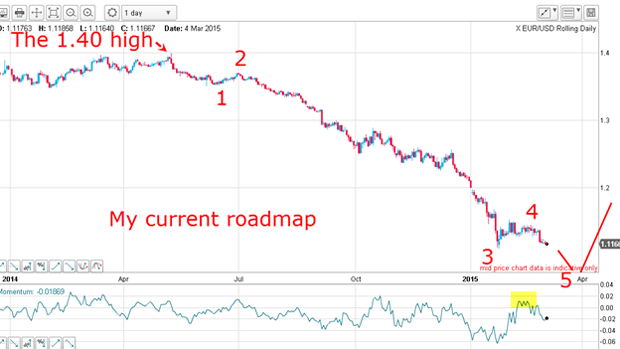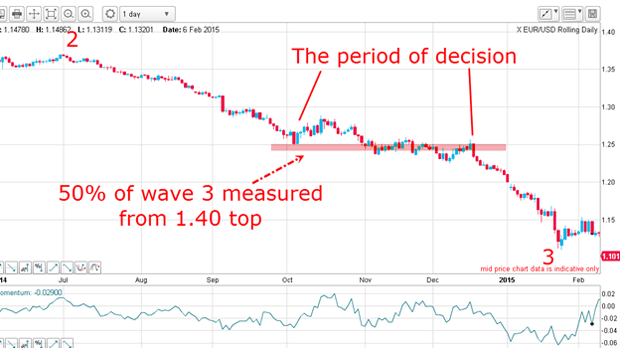Two indicators are telling me the euro will bounce at 1.05
Long-term charts can be very handy when it comes to working out where a currency is heading. John C Burford explains.
Since I wrote Wednesday's post, the euro has crashed below my wave 3 low at 1.11, and confirmed my Elliott wave count:

The market is now well and truly in a final fifth wave. But how low can it stretch?
There is one little-known feature of a classic motive five-wave pattern: in a genuine, extensive third wave, such as we have here, the waves start out from a high as bulls start to become disenchanted with their position and abandon their trades.
MoneyWeek
Subscribe to MoneyWeek today and get your first six magazine issues absolutely FREE

Sign up to Money Morning
Don't miss the latest investment and personal finances news, market analysis, plus money-saving tips with our free twice-daily newsletter
Don't miss the latest investment and personal finances news, market analysis, plus money-saving tips with our free twice-daily newsletter
Remember, near the 1.40 high, bullish sentiment was dominant; as the market started to drop, this degree of bullishness was only reduced gradually as more bullish traders realised they were on the wrong side of the market.
As the third wave got into gear in the summer, the decline became steeper (JulySeptember 2014 period). The bulls and the bears were becoming more evenly matched.
By September, however, bullish sentiment was a mere fraction of that at the top and the market became choppier with large rallies.
When the penny dropped, so did the markets
I call that the period of decision' and it usually occurs about half way along wave 3 as measured from the top.
If you look closely, you will find that the choppy period of decision does indeed lie about half way along wave 3:

Halfway down wave 3, the market is darting up and down in wider swings than before, or after. This shows the market is unsure about direction and it took about two and a half months to make up its mind. This was a very tricky period in which to trade.
When traders finally made up their collective mind, the market went hard down to the wave 3 low in January.
That help explains my wave 3 low at 1.11.
How long will the euro keep falling?
Let's go back to the very long-term chart for possible clues:

This is a very interesting chart. I have drawn in a tramline pair stretching over many years, and it is the lower tramline that grabs my attention.
I have a pair of prior pivot points (PPPs) and three highly accurate touch points (purple arrows). Just admire how beautifully the PPPs and the lows line up precisely on the tramline over a period of almost nine years. This is utterly textbook.
So, where does the tramline project to? If the market does reach the lower tramline in the final fifth wave, it will hit the 1.05 area. And if it overshoots, it could come close to the magic level of parity.
There is another very interesting feature of this long-range chart. Notice the gap at the start of the year; it is a breakaway gap, a well-established feature in classical charting (though rare in today's 24-hour markets).
Breakaway gaps usually occur about half-way along a trend. So, if we measure from the 1.40 high to the mid-point of the gap at around 1.22, that projects a target around 1.04 very close to the 1.05 tramline target.
I've two independent targets at the 1.04 1.05 area. How very interesting!
Get the latest financial news, insights and expert analysis from our award-winning MoneyWeek team, to help you understand what really matters when it comes to your finances.
John is is a British-born lapsed PhD physicist, who previously worked for Nasa on the Mars exploration team. He is a former commodity trading advisor with the US Commodities Futures Trading Commission, and worked in a boutique futures house in California in the 1980s.
He was a partner in one of the first futures newsletter advisory services, based in Washington DC, specialising in pork bellies and currencies. John is primarily a chart-reading trader, having cut his trading teeth in the days before PCs.
As well as his work in the financial world, he has launched, run and sold several 'real' businesses producing 'real' products.
-
 Metals and AI power emerging markets
Metals and AI power emerging marketsThis year’s big emerging market winners have tended to offer exposure to one of 2025’s two winning trends – AI-focused tech and the global metals rally
-
 8 of the best houses for sale with beautiful fireplaces
8 of the best houses for sale with beautiful fireplacesThe best houses for sale with beautiful fireplaces – from a 15th-century cottage in Kent to a 17th-century palazzo in Oxfordshire